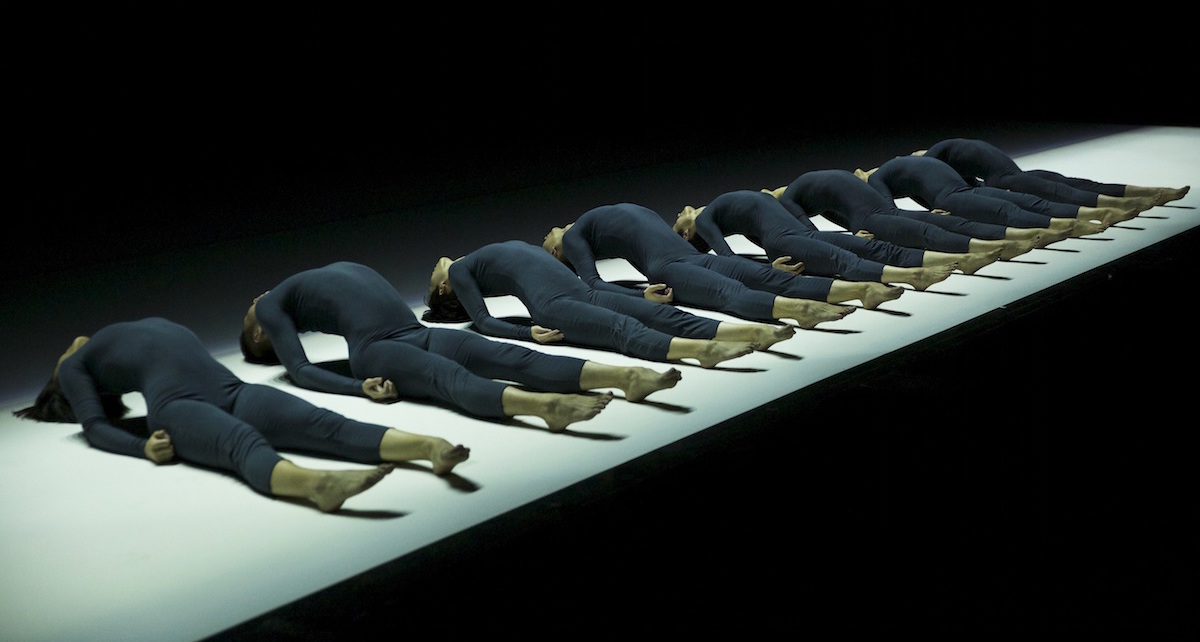Arts Centre Melbourne, Melbourne.
22 February 2017.

Tao Ye’s TAO Dance Theater in ‘6’. Photo by Fan Xi.
The work of Chinese choreographer Tao Ye raises far more questions than it would ever claim to answer. Beautiful and hypnotic on the one hand, ruthless and ideological on the other, it stalks the uneasy territory between minimal grace and puritanical, man-machine madness. Is this the triumph of a magnificent abstract vision executed without fear or pandering, or is it the reification of masculine linear control?
With their brutal, architectural rigour and focus on repetition and conformity, 6 and 8 both beguile and confront. By “reducing” the dance to straight lines and tightly patterned movements, Ye endeavours to strip out context, to eliminate cultural, individual and narrative elements and to leave his audiences the space to overlay their own reading. Whilst this approach maintains the curious appeal of an idea boldly pursued to an extreme, it also thrusts us into a mid-century totalitarian dystopia, where cold beauty excuses industrial inhumanity.
That said, all of this hand-wringing discomfort may well be part of the Tao Dance masterplan; because once we eliminate the Western bourgeois comfort zones of virtuoso performance and storybook arcs, we are left simply with ourselves – and for most of us there is no more disconcerting experience than that we be left with the unobscured self.

Tao Ye’s TAO Dance Theater in ‘8’. Photo by Zhang Shengbin.
Despite this, 6 and 8 are still dance. Still performative. Indeed, 6 in particular is compelling and trance-like, with its hazy, shifting colour palette, mesmeric string soundtrack and gradually intensifying movement. The starkness of its vision is softened by gentle lighting and by the very fact that the six dancers are never exactly in sync. Seeing them in a tight line, we can detect minute, human variations, and thus the purist rigidity of that line takes on some of the undulating gentleness of a wave. There is an organic asymmetry after all. Chaos in the maths.
By contrast, 8 sees the ensemble on a white floor for the duration. With spine-testing, repetitive arching movements, they creep upstage and back. Here, the more soulless qualities of Ye’s approach are evident. Not only are the dancers brutalised by the choreography, but the audience is given no relief from the inevitable mechanical momentum. You know how it’s going to end and nothing you can do will change it. The relentlessness is breathtaking and, at times, even galling. The individual, so primary in the folklore of the contemporary West, is airbrushed out, and we are left wondering if this is an example of sublime harmony or crushing tyranny.

Tao Ye’s TAO Dance Theater in ‘8’. Photo by Zhang Shengbin.
While Tao Dance Theater refused to bend their own rules, however, I will certainly break the custom of the so-called critic by mentioning that my view of 6 and 8 was influenced by the comments of my guest (herself a choreographer of Chinese extraction) and by other dancers and artists I met in the foyer. This is not so much to validate their views but to underline the point that Ye’s modus operandi is effective in at least one crucial regard; namely, that it stimulates an uncomfortable ambiguity that forces us to drill into both the work and our responses to it. I am sure I could bore you senseless with an exhaustive list of “is it this or was it that” questions, (and there are literally dozens of them), but the bottom line is that 6 and 8 live and move in difficult conceptual and creative space.
At the end of the night, this may well be little more than high art line dancing. It may even be “jumping the shark”. One thing, however, is certain. You won’t forget it in a hurry.
By Paul Ransom of Dance Informa.















